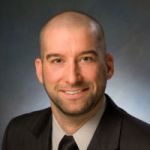ON-DEMAND WEBINAR
This presentation will cover a detailed explanation of the challenges and solutions facing through-wall flashings and transition membranes, provide a thorough description of the characteristics of several types of membranes, emphasize the importance of compatibility, and explain proper installation techniques.
It is important to understand the latest in test methods, current and projected code requirements, training and certification requirements and resources to allow you to specify this requirement.
Learning Objectives:
- Cover the performance criteria used to specify through-wall flashings and transition membranes.
- Cover how to design a resilient and durable flashing system that will minimize life cycle costs.
- Define the attributes of a variety of membrane materials.
- Recognize the compatibility between cavity wall components.
 Meagan Elfert, CDT, MBA, CBS, is the Vice President for York Flashings and has been part of the York team for nine years. She manages York’s sales team across all regions of the USA and oversees the strategic direction of the organization. Meagan provides educational sessions for contractors and performs jobsite visits to bring installers the latest technology and best flashing practices. She is currently active in the local Building Enclosure Council Research Triangle chapter of North Carolina and is the electronic communications chair. Meagan is also part of the IIBEC Carolinas Chapter, the Air Barrier Association of America, the North Carolina Masonry Contractors Association, and is on the board for Target Community and Educational Services, Inc.
Meagan Elfert, CDT, MBA, CBS, is the Vice President for York Flashings and has been part of the York team for nine years. She manages York’s sales team across all regions of the USA and oversees the strategic direction of the organization. Meagan provides educational sessions for contractors and performs jobsite visits to bring installers the latest technology and best flashing practices. She is currently active in the local Building Enclosure Council Research Triangle chapter of North Carolina and is the electronic communications chair. Meagan is also part of the IIBEC Carolinas Chapter, the Air Barrier Association of America, the North Carolina Masonry Contractors Association, and is on the board for Target Community and Educational Services, Inc.
There seems to be a lack of understanding of what quality assurance entails versus quality control, the fundamental differences between the two, and what each function brings to the table. This is not unique to the ABAA air barrier quality assurance program or the construction industry in general. These terms are used interchangeably and misunderstood in all industries.
In this presentation, a discussion of how to implement quality assurance and quality control will be explored specific to the building enclosure, and the steps you can take to ensure a high-performance building.
Learning Objectives:
- Explore how quality management systems can be applied to the construction process, and how quality assurance differentiates with quality control.
- Assess potential impacts to cost, scheduling, building performance, and durability by poor installation of air barriers.
- Describe language required in a specification that provides key criteria in regards to implementing an air barrier site quality assurance program.
- Define key components of an air barrier site quality assurance program, and assess the importance and relationship of each component.
 Laverne Dalgleish, CABS, Executive Director Air Barrier Association of America
Laverne Dalgleish, CABS, Executive Director Air Barrier Association of America
Mr. Laverne Dalgleish was requested in 2000 to organize a trade association that would focus on the air barriers that were going to become a requirement in the Commonwealth of Massachusetts building code on July 1, 2001, specifically to deal with training the installers.
Laverne had managed trade associations and had developed a Site Quality Assurance Program based on his work in developing standards at the International Organization for Standardization (ISO).
Over the years, Laverne has spearheaded the development of material specifications, test methods, training courses, installer certification and research projects, all to bring organization and technical documents that were used to grow the air barrier industry.
Over the years, Laverne has become a frequent presenter across North America and Internationally on a variety of topics as they relate to building envelopes, energy efficiency, green building practices, and standards and quality of construction.
This presentation reviews a variety of building types to discuss the continuity of detailing required to manage moisture, air, vapor, and thermal performance, as well as wind resistance requirements at the critical wall-to-roof interface. This session will provide guidelines to successfully navigate these often competing interests and provide strategies for achievable performance through design and specification without compromising the aesthetics with distracting details for commercial building wall systems. This presentation discusses the impacts of whole building performance, design requirements, material & assembly requirements, and installation verification requirements during construction.
Learning Objectives:
- Discuss the requirements to manage moisture, air, vapor, and thermal continuity.
- Recognize the changing building and energy codes, and their interaction across building enclosure system interfaces.
- Apply specific examples and air barrier systems to current and future project designs.
- Outline design and specification requirements to set performance requirements for wall systems.
 Benjamin Meyer, AIA, NCARB, LEED AP is the Building Enclosure Business Director for Siplast. He has worked previously in building envelope product technical management, commercial design, real estate development and construction management on a range of projects that included residential, educational, offices, and DuPont industrial projects. Industry positions include: Voting Member of the ASHRAE 90.1 Envelope and Project Committees, Board of Directors of the Air Barrier Association of America (ABAA), Co-chair of the Codes Task Group (ABAA), LEED Technical Committee member, and past Technical Advisor of the LEED Materials (MR) TAG. Mr. Meyer has MBA, B.S., and M.Arch degrees from the University of Cincinnati.
Benjamin Meyer, AIA, NCARB, LEED AP is the Building Enclosure Business Director for Siplast. He has worked previously in building envelope product technical management, commercial design, real estate development and construction management on a range of projects that included residential, educational, offices, and DuPont industrial projects. Industry positions include: Voting Member of the ASHRAE 90.1 Envelope and Project Committees, Board of Directors of the Air Barrier Association of America (ABAA), Co-chair of the Codes Task Group (ABAA), LEED Technical Committee member, and past Technical Advisor of the LEED Materials (MR) TAG. Mr. Meyer has MBA, B.S., and M.Arch degrees from the University of Cincinnati.

Jennifer Keegan, AAIA, is the Director of Building & Roofing Science for Siplast, focusing on overall roof system design and performance. Jennifer has over 20 years of experience as a building enclosure consultant specializing in building forensics, assessment, design and remediation of building enclosure systems. She provides technical leadership within the industry as the Chair of the ASTM D08.22 Roofing and Waterproofing Subcommittee, and the education chair for IIBEC; and as an advocate for women within the industry as an executive board member of National Women in Roofing and a board member of Women in Construction.
Building movement will happen whether or not we want it to. If we do not account for where movement will occur, during design and construction, the building will find its own way to move.
This course will cover why building movement joints are needed, the differences between various types of joints, how expansion joints should provide continuity of the air and water control layers, as well as samples of what failures can occur. We will also review a case study showing failures which can happen when expansion joints are not designed and installed.
Learning Objectives:
- Review best practices for location of expansion joints on building enclosures.
- Identify the difference between expansion, control, and isolation joints.
- Investigate building failures caused by poor expansion joint design and lack thereof, and premature failure due to improper installation.
- Cover the causes of sealant failure, and the importance of proper joint design and how it can dictate performance.
 Melissa I. Payne focuses on offering building enclosure third-party services. She founded Midwest Enclosure Consulting, September 2022, to offer owners, design, and construction teams with expertise in building science, building envelope solutions, forensic investigations, as well as building performance assessments and construction onsite inspections.
Melissa I. Payne focuses on offering building enclosure third-party services. She founded Midwest Enclosure Consulting, September 2022, to offer owners, design, and construction teams with expertise in building science, building envelope solutions, forensic investigations, as well as building performance assessments and construction onsite inspections.
Ms. Payne joined Tremco CPG Inc. November 1, 2018, as a Construction Management Specialist. She then managed the Enclosure System Solutions Team starting in February 2021, and administered the MyTEAM Leak-Free Warranty Processes and Services till April 25, 2023, at which time the company decided these services would no longer be offered under Tremco CPG, Inc.
Prior to joining Tremco, she provided building enclosure commissioning and consulting service and conducted forensic investigations on a multitude of projects while at Miller Engineering, P.C. Prior to developing and heading the building enclosure division at Miller, she served as the Owner’s Representative on both capital and non-cap construction and restoration projects for City Utilities of Springfield, Missouri, a municipal utility company.
Ms. Payne possesses a strong foundation in industry standards related to building envelope commissioning processes, commissioning authority, building science, construction observation, performance testing, project management, and general construction of building envelope systems including: institutional, schools, higher education, government, healthcare, hospitality, and industrial projects. Her owner representative, third-party consulting experience, forensic work, commissioning provider background, and manufacturer internal consultant involvement gives her an all-enveloping perspective of the design and construction industry.
Modern high-performance building enclosures utilize control layers to manage heat, air, water, and vapor transport through walls, roofs, waterproofing, and fenestrations. This presentation will provide an introduction to the building science of these key four phenomena of building physics, the mechanism for how they work, and strategies for controlling their transport in assemblies. The goal of this presentation is that each participant will be able to identify how common building materials (e.g. WRBs, insulation, curtain wall, concrete, etc.) are able to control air, heat, water, and vapor and describe which metrics are used to quantify those movements. These metrics will be shown in the context of the requirements of common buildings codes and industry standards. Recent building science research will be shared along with developments and upcoming changes to these metrics.
Learning Objectives:
- Cover the mechanisms of heat, air, bulk water, and vapor and how they transport through building assemblies.
- Recognize the importance of air barriers and common challenges with their installation.
- Cover the benefits of continuous insulation and common challenges to achieving it in the field.
- Explore key strategies for achieving durable, energy-efficient, and thermally comfortable wall, roof, and below-grade assemblies
 An expert in building enclosure technology, Keith Simon addresses the critical and often unmet need for ensuring and improving building performance, resilience, and durability by guiding design teams, educating future architects, and facilitating interdisciplinary exchange. Keith joined Building Exterior Solutions, Inc. (a division of Terracon) in 2014. He is a Certified Passive House Consultant (CPHC), Legacy LEED AP, Building Enclosure Commissioning Provider (BECxP), and Fellow of the American Institute of Architects (AIA) with over 20 years’ experience in architectural design and building enclosure consultation. His experience includes peer review, design assistance, durability analysis, construction administration, testing, and forensics of building envelope issues. Keith was the founder of the AIA Austin Building Enclosure Council (BEC: Austin) and currently serves as a board member for BEC: Austin and the Passive House Institute US (PHIUS) Alliance Austin Chapter. He also serves as the Vice Chair for the National Institute of Building Sciences (NIBS) Building Enclosure Technology and Environment Council (BETEC) executive committee and is the South Region Representative for the PHIUS Alliance Executive Council.
An expert in building enclosure technology, Keith Simon addresses the critical and often unmet need for ensuring and improving building performance, resilience, and durability by guiding design teams, educating future architects, and facilitating interdisciplinary exchange. Keith joined Building Exterior Solutions, Inc. (a division of Terracon) in 2014. He is a Certified Passive House Consultant (CPHC), Legacy LEED AP, Building Enclosure Commissioning Provider (BECxP), and Fellow of the American Institute of Architects (AIA) with over 20 years’ experience in architectural design and building enclosure consultation. His experience includes peer review, design assistance, durability analysis, construction administration, testing, and forensics of building envelope issues. Keith was the founder of the AIA Austin Building Enclosure Council (BEC: Austin) and currently serves as a board member for BEC: Austin and the Passive House Institute US (PHIUS) Alliance Austin Chapter. He also serves as the Vice Chair for the National Institute of Building Sciences (NIBS) Building Enclosure Technology and Environment Council (BETEC) executive committee and is the South Region Representative for the PHIUS Alliance Executive Council.
Can you see air leaks and see water leaks in your new building right away? Do you want your project finished only to then find out that you have installation deficiencies? Do you want project delays for rework due to faulty installation? We didn’t think so either and we’re here to help! When you specify the ABAA QAP program, you receive a risk management program that address the potential issues during the installation process. The installation is performed by individuals and companies that are educated and have the experience to properly install air barriers. But it does not stop there! The Site Quality Assurance Program addresses a wide range of items which can impact the installation. Find out more about the program, the costs, benefits and how to successfully execute your air barrier installation.
Learning Objectives:
- Determine the impacts of air leakage that can be quantified.
- Assess potential impacts to cost, scheduling, building performance and durability by poor installation of air barriers.
-
Define key components of an air barrier site quality assurance program and assess the importance of each component and how they interrelate.
- Describe language required in a specification that provides key criteria in regards to implementing an air barrier site quality assurance program to reduce liability and risk.
 Ryan Dalgleish has been involved in the building enclosure and building performance areas of construction in both the commercial and residential sectors for over 20 years. He acts in the position of Chief Operating Officer for the Air Barrier Association of America. Ryan is a certified Net Zero building instructor, teaches master builder courses to builders across the country and is a frequent speaker at various technical presentations dealing with the building enclosure to various building official associations, city departments, building enclosure councils and chapters of the American Institute of Architects, Construction Specifications Institute and a number of local home builder associations.
Ryan Dalgleish has been involved in the building enclosure and building performance areas of construction in both the commercial and residential sectors for over 20 years. He acts in the position of Chief Operating Officer for the Air Barrier Association of America. Ryan is a certified Net Zero building instructor, teaches master builder courses to builders across the country and is a frequent speaker at various technical presentations dealing with the building enclosure to various building official associations, city departments, building enclosure councils and chapters of the American Institute of Architects, Construction Specifications Institute and a number of local home builder associations.
Critical details that typically cause building performance related issues will be focused on one of the largest failures of building enclosures: wall to window connections specific to curtain wall systems and storefronts. A step-by-step look at each critical detail in regards to sequence of construction and the various connections to ensure airtight/watertight and thermally protected details. Real life photos and job conditions will highlight the realities of the construction process to show typical errors found and how those errors can be addressed correctly.
Learning Objectives:
- Articulate how transitions impact building enclosure performance through real life experiences regarding energy loss, building performance and the sustainability of the system.
- Correctly identify and prioritize critical details during the construction document phase to ensure an integrated approach is taken to heat, air, water and vapor control.
- Assess each detail for storefront and curtain wall regarding impacts of the four control layers and understand the various options for designing details for a variety of roof, wall and window assemblies.
- Using real-life case studies and photos, plan out the proper sequence of construction and identify quality control methods in construction document review to provide corrective action.
 Andrew Dunlap’s, AIA, NCARB, LEED AP, primary work experience is focused on the analysis and development of building enclosure systems including wall cladding assemblies, air barrier systems, roofing, skylights, fenestration systems and waterproofing. Specializing in the energy and hygrothermal evaluation and analysis of wall, fenestration, and roof systems, Andrew utilizes a number of advanced computerized analysis and simulation tools to perform his work. He received his B. Arch, B.S. in Mathematics, and M. Arch degrees from the University of Detroit Mercy. Andrew is also active participant in the design and construction community, providing presentations and publications to several industry organizations.
Andrew Dunlap’s, AIA, NCARB, LEED AP, primary work experience is focused on the analysis and development of building enclosure systems including wall cladding assemblies, air barrier systems, roofing, skylights, fenestration systems and waterproofing. Specializing in the energy and hygrothermal evaluation and analysis of wall, fenestration, and roof systems, Andrew utilizes a number of advanced computerized analysis and simulation tools to perform his work. He received his B. Arch, B.S. in Mathematics, and M. Arch degrees from the University of Detroit Mercy. Andrew is also active participant in the design and construction community, providing presentations and publications to several industry organizations.
